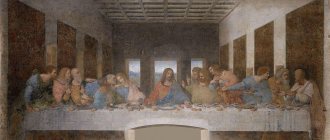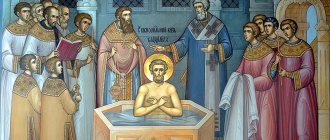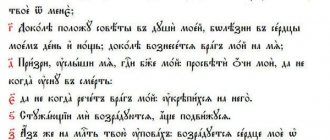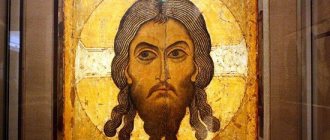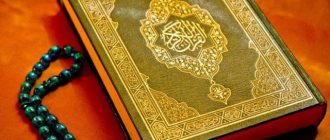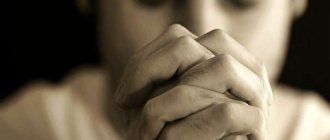Surely every person who believes in the Lord has heard this icon. As a rule, the Last Supper icon is located above the main entrance of the church and people who often visit the church can see it. Moreover, even those who have never been to the temple and have not visited a single holy place may be familiar with this icon thanks to the famous fresco painted by Leonardo da Vinci.
History of writing the image
The event, which occurred more than 2000 years ago, served as inspiration for many artists. The fresco “The Last Supper” created by Leonardo da Vinci became a world masterpiece. Appearing in the 16th century, the painting is distinguished by its unique painting technique. The Savior is located in the center, and on the sides he is surrounded by the apostles, who are divided into groups.
Appearing in the 16th century, the painting is distinguished by its unique painting technique.
The Christian icon and Da Vinci's fresco are different in the semantic load underlying their plot. The artist wanted to convey the reaction of the followers of Christ to the news of the betrayal of their teacher. However, not a single artist has been able to accurately recreate the place where the supper was held.
Studying the historical records of those times, art historians came to the conclusion that long tables and chairs did not yet exist. Food was placed on benches, and people sat on cushions. This gave rise to the assumption that the dining table is a symbol of the ritual of the Eucharist, which the Savior presented to his disciples on the last evening. The Orthodox Church uses a long table as a prototype of the church throne, which is located in the altar part of the temple.
The icon can be placed both in the kitchen and on the home iconostasis
There are no strict canons regarding where to hang an icon on a home iconostasis. For example, like the “Holy Trinity,” it can be hung on top of the images of Jesus Christ and the Mother of God. It would be appropriate to place the image in the dining room to pray before eating. Or in the kitchen, where the housewife can read a short prayer before starting to prepare food.
Fresco by Leonardo da Vinci
In art, many authors have sanctified this biblical story. The most famous work is the fresco by Leonardo da Vinci, which adorns the wall of the refectory of the Dominican monastery of Santa Maria delle Grazie in Milan. The painting was commissioned by Duke Lodovico Sforza; da Vinci worked for about three years and completed the painting in 1498.
3 years
approximately how long Leonardo da Vinci worked on the fresco
It is believed that in the fresco the artist captured the reaction of the apostles to Jesus’ words that one of them would betray him. And from the found notebooks of Leonardo da Vinci, the names of all the depicted apostles were established, although before that only Judas, Peter, John and Christ had been identified.
Icons and paintings are distinguished by a variety of subjects: in some Judas is depicted without a halo, in others all the apostles are turned to face us, in others the apostles are sitting on benches or chairs... This affects individual elements of the work, but the meaning and significance of the icon as a whole remains unchanged.
Description of the Last Supper icon
History has many created images of the Last Supper, all of which are intended to show different aspects of the act that took place. However, there are canons that can be seen on all canvases. Christ is located in the center of the table, and all his disciples are gathered on both sides of him. On the table is a cup of wine and bread, which they shared on Easter Eve.
Christ and his followers are often depicted with halos, while Judas does not. All the apostles turn to their teacher and listen to his words. Only Judas stands out, reaching for a glass of wine, which symbolically shows his vulgarity and denial of the words of the Savior. Sometimes he is depicted with a wallet in his hands, which contains coins received for betrayal.
Stained glass image
Antique tapestries
Stone bas-reliefs
What is the name of the Seraphim-Diveyevo icon?
The question of the name of the miraculous image is also quite interesting. The now accepted name for this icon is Seraphim-Diveevskaya. However, along with this, other names for this image are also common. Among them is simply “Tenderness”. “Tenderness of the Mother of God” is also one of the options for the name of this image.
Often the icon is called “female”, the names of monasteries are attached to it, for example, Trinity, where before the revolution the image had its own separate limit, it is often simply called Seraphim or Sarov. The ascetic Seraphim himself called the image “The Joy of All Joys.”
The meaning of the icon and hidden symbolism
The plot depicted in the picture is understandable even to those who are superficially familiar with the Holy Scriptures. Understanding the meaning of the sacrament that takes place at the evening sooner or later comes to every person. Christians know that a certain sacrament is celebrated in church all year round, which is called the Eucharist.
It was given by the Savior to his apostles at the last supper, which took place 2000 years ago. Passover in those days was celebrated in honor of the liberation of the Jewish people from Egyptian oppression. On the eve of the holiday, Jesus Christ personally washed the feet of the disciples and shared the last meal with them. On it he broke bread with his followers, which became a symbol of his suffering body. Then he presented wine as a treat, a symbol of his blood and cleansing from sins.
The description of the acts that happened that evening does not reflect the fullness of the deep meaning inherent in the icon. At the moment of the sacrament, Judas had already betrayed his teacher, for whom this was not a secret. The plot is intended to show that every person is capable of turning away from the righteous path and betraying the Almighty. However, not everyone can sincerely repent of their actions. The icon fills with the feeling that God is waiting for every person to come to Him with repentance until their last breath.
The icon depicts the last meal of Christ with the apostles
That evening, the Savior and his disciples celebrated the Old Testament Jewish Passover - the holiday of the exodus of the ancestors of the Jews from Egypt. The events took place several thousand years before Christ. It was at night that every Jewish family had to slaughter a lamb and mark the doors of their homes with its blood so that the Lord would not direct his anger at them. All the firstborn of the Egyptians died that night.
Thus, God the Father punished them for keeping the Jews in slavery. Only after this did Pharaoh release the tribe of the Jews, led by the prophet Moses, to the Promised Land.
30 pieces of silver
Judas received for betraying Christ
The secret meeting of Jesus with the apostles was because Christ was already wanted to be accused of spreading Christian teaching in the territory of Judea and to be executed.
The Savior knew that this was the last meeting and foresaw the betrayal of Judas: “and while they were eating, he said, “Truly I say to you, that one of you will betray Me” (Matthew, 21). Historians claim that Judas took 30 pieces of silver for betrayal, the bag with which he keeps on the icon.
The painting depicts Judas without a halo
Jesus showed true Christian humility by performing the ritual of washing the feet of the disciples. This event is described only in the Gospel of John:
(John 13:3-17)
“Jesus, knowing that the Father had given all things into His hands, and that He had come from God and was going to God, stood up from supper, took off His outer garment, and, taking a towel, girded Himself. Then he poured water into the washbasin and began to wash the disciples’ feet and dry them with the towel with which he was girded. He approaches Simon Peter, and he says to Him: Lord! Should you wash my feet? Jesus answered and said to him, “What I do you do not know now, but you will understand later.”
Peter says to Him: You will never wash my feet. Jesus answered him: If I do not wash you, you have no part with Me. Simon Peter says to Him: Lord! not only my feet, but also my hands and head. Jesus says to him: he who has been washed only needs to wash his feet, because he is all clean; and you are clean, but not all. For He knew His betrayer, and that is why He said: You are not all pure. When he had washed their feet and put on his clothes, he lay down again and said to them: Do you know what I have done to you?
You call Me Teacher and Lord, and you speak correctly, for I am exactly that. So, if I, the Lord and Teacher, washed your feet, then you should wash each other’s feet. For I have given you an example, that you also should do the same as I have done to you. Truly, truly, I say to you, a servant is not greater than his master, and a messenger is not greater than the one who sent him. If you know this, blessed are you when you do it.”
Bas-relief "The Last Supper"
What helps and what they pray for
For an Orthodox Christian, the icon serves as a guide to the Almighty, who hears the prayers of his slave . People turn to her with pleas for help and repentance for their actions. Temples and churches place it in close proximity to the altar, emphasizing the special symbolism of the image.
The icon helps in the following actions:
- serves as a conductor between the Almighty and the prayers of believers who reveal their worries to him and try to find peace of mind;
- when preparing food, the housewife asks for instructions so that the food turns out tasty;
- before and after the meal, prayers of thanksgiving are offered;
- not far from the holy image people receive communion;
- those who have sinned ask for forgiveness of their deeds.
The bread and wine offered by Jesus symbolize his flesh and blood
The only food depicted on the icon is the communion cup and bread. During the meal, Jesus Christ
(Luke 22:19)
“Taking bread and giving thanks, he broke it and gave it to them, saying: This is My body, which is given for you; do this in remembrance of Me"
And while distributing wine, he said:
(Luke 22:20)
“Likewise the cup after supper, saying, This cup [is] the New Testament in My blood, which is shed for you.”
Thus Jesus established the Eucharist, the Sacrament of Communion. By eating the Body and Blood of Christ, we become part of Him and at the same time give thanks for the sacrifice that the Savior made, freeing humanity from original sin at the cost of His torment.
The establishment of the sacrament of the Eucharist by the Orthodox Church is remembered on Maundy Thursday, and the Sacrament of Holy Communion is the basis of the church liturgy - the main Christian service.
In front of the icon you can ask for forgiveness of sins, both in church and at home.
An Orthodox Christian should not have a question about whether the Last Supper icon is needed in the house, because many people know what the image helps with:
- by analogy with other icons, it gives the opportunity to talk with God, tell him about your difficulties, share your joys or worries;
- helps to find peace of mind;
- if the icon hangs in the kitchen, the housewife should ask for a blessing for cooking by reading “Our Father” or “Lord, bless!”;
- before and after eating, prayer in front of the icon means gratitude for the opportunity to eat food;
- in the temple the icon is placed above the Royal Doors, in the center of the temple iconostasis, and everyone who comes to the church can turn to it for a blessing;
- in the church they pray in front of her for permission to receive the Holy Gifts;
- in front of this icon of the Almighty they ask for forgiveness of sins.
Location of the divine image
The image is in the Dominican monastery of Santa Maria delle Grazie in Milan. The fresco, approximately 4x8 in size, is located in the refectory of this monastery, on one of the walls.
The shrine is located in the monastery of Santa Maria delle Grazie in Milan
Where to place the holy image in the house
The location in the house does not change the deep meaning of the holy image. The image can be in the kitchen or living room. They turn to the holy image at any time when they want to tell about their thoughts. For housewives involved in cooking, the image sends a blessing for successful completion of tasks.
Christians believe that hanging an icon in the bedroom is unacceptable. The church does not give specific prohibitions on this. The home of an Orthodox person is filled with icons, which are located almost everywhere.
The only exception is the bathroom, where the placement of holy images is unacceptable.
Where is the icon located?
No one can know exactly what time this event took place. It is also impossible to know exactly how it became known that a traitor was at the dinner. One thing is certain: if a person is imbued with faith and wants to decorate his home with the face of saints, then he can undoubtedly hang an icon depicting the Last Supper.
If we consider where to hang the Last Supper icon, the meaning does not change depending on the room. Many people prefer to hang it in the kitchen or dining room. This image can help everyone who wants to communicate with the Lord and tell him about their troubles. In addition, this image can send a blessing that helps in preparing food. Before and after a meal, praying in front of this icon can express gratitude to God for the food sent.
In general, the meaning of the Last Supper icon is fundamental for believers, as it speaks of one of the most significant gospel events and the feat of Christ.
Many people consider it unacceptable to place such an image in the bedroom, but just like in the kitchen, there are no prohibitions here. If we are talking about an Orthodox home, then icons can be located almost everywhere (perhaps, unless the bathtub is an unacceptable option). Otherwise, the blessing of the icon will help both in the kitchen and in the bedroom.
Celebration and folk signs
The events of the Last Supper are given a special day during Holy Week, namely Maundy Thursday. On this day, the entire Orthodox world remembers the sacrament performed at the evening and empathizes with the suffering experienced by the savior on Calvary. Believers shed tears at the predicted death and rejoice at the resurrection. At the end of the service, they are introduced to the teachings of Christ by confessing and receiving communion.
Traditions observed on Maundy Thursday:
- righteous Christians must visit the bathhouse and take a bath to cleanse themselves;
- In ancient Rus', peasants went to the river and filled a bucket of clean water. She was considered sanctified and helped to wash away all sins;
- one could regain health on this day by voluntarily giving a personal item to the river, along with which illnesses and adversities would be carried away;
- Russian women were not able to visit the river because they were busy preparing food and setting a large table for guests. The children made paints because there was little time left before Easter;
For an Orthodox Christian, the icon serves as a guide to the Almighty
The veneration of the icon takes place on Maundy Thursday of Easter week.
The Last Supper icon serves as a reminder of the saving sacrifice of Jesus Christ. From the last joint meal of the Savior with His apostles, the Passion of Christ began, ending with His earthly death and subsequent Resurrection. Therefore, the veneration of the icon falls on Maundy Thursday (Maundy Thursday) of Easter week. It is on this day that the sacrifice of Christ begins to be remembered and preparations for the holiday of Great Easter begin.
Photo of the sculpture “The Last Supper” by Albert Szukalski
Prayer and Akathist to the Last Supper Icon
Prayer to the Last Supper icon:
“Today, O Son of God, receive me as a partaker of Thy secret Supper: I will not tell the secret to Thy enemies, neither will I give Thee a kiss like Judas, but like a thief I will confess Thee: remember me, O Lord, in Thy Kingdom. May the communion of Thy Holy Mysteries be not for judgment or condemnation for me, Lord, but for the healing of soul and body. Amen. Master Lord Jesus Christ my God, who, for the sake of Your ineffable love for mankind, at the end of the ages was clothed in flesh by the Ever-Virgin Mary, I glorify Your saving providence for me, Your servant, Master; I will sing praises to You, because for the sake of the Father I have known You; I will bless You, for whose sake the Holy Spirit has come into the world; I bow to Your Most Pure Mother in the flesh, who served such a terrible secret; I praise Your angelic faces, as the singers and servants of Your Majesty; I honor John the Baptist, who baptized You, O Lord; I honor the prophets who proclaimed You, I glorify Your holy apostles; I triumph and the martyrs, and I glorify Your priests; I worship Your saints, and I cherish all Your righteous ones. I bring such and such a many and ineffable face of the Divine into prayer to You, Thy all-generous God, Thy servant, and for this sake I ask forgiveness for my sin, grant me all of Thy for the sake of the saints, more abundantly than Thy holy bounties, for Thou art blessed forever. Amen".
Troparion for Maundy Thursday, tone 8:
“When the glory of the disciple / at the thought of the supper was enlightened, / then the evil Judas, / sick with the love of money, became darkened, / and betrayed the Righteous Judge to the lawless judges. / See, the steward of the estate, / used strangulation for these sake! / Flee the unsatiated soul, / To such a teacher who has dared: / Who is good to all, O Lord, glory to Thee.”
Kontakion for Maundy Thursday, tone 2:
“The traitor receives bread in his hand, / he stretches it out in secret, / and accepts the price of the One who created man with His own hands, / and Judas, the slave and flatterer, remains uncorrected.”
The Last Supper icon represents the turning point, after which the disciples will discover the divine nature of Jesus Christ and the example of sacrificial love for the Almighty. The events of that evening help devout Christians strengthen their faith in difficult situations, turning sadness into hope.
If you find an error, please select a piece of text and press Ctrl+Enter.
The history of the image of the Blessed Virgin Mary “Tenderness”
The image of “Theotokos of Tenderness” was the cell shrine of St. Seraphim. His entire life passed under the visible and invisible cover of the Virgin Mary from childhood. She came to him and said: “This one is of our kind.” The monk departed to the Lord while praying in front of this icon.
When the monastery was closed during the October Revolution, the shrine was secretly removed and saved from desecration. For many years it was kept by pious Orthodox Christians.
The image of “Theotokos of Tenderness” was the cell shrine of St. Seraphim. A large number of copies were made from this image and they acquired, as it were, additional “patronymics”: “Tenderness” Lokotskaya, Smolenskaya, Pskov-Pecherskaya. This is due to the manifestation of the miraculous properties of icons in the spiritual abodes where they are located.
